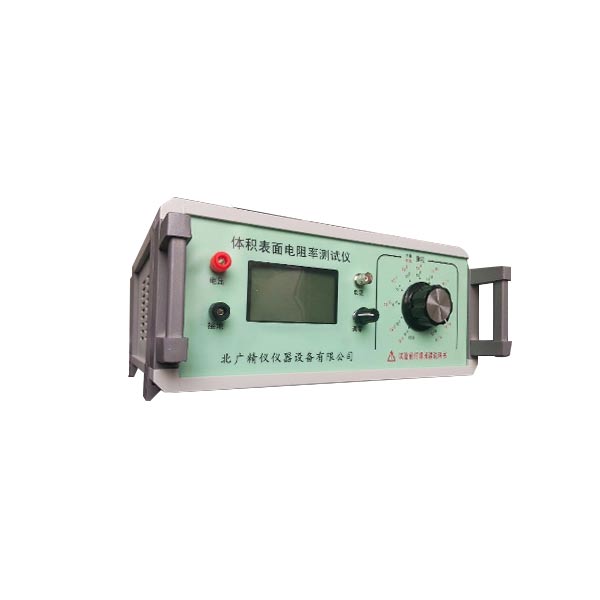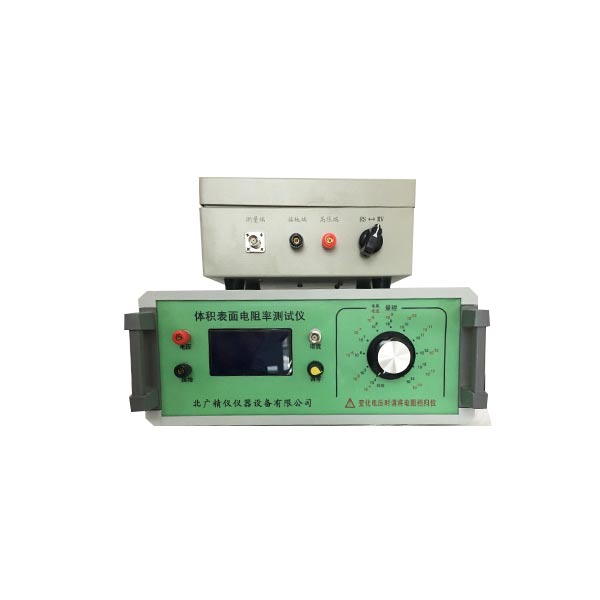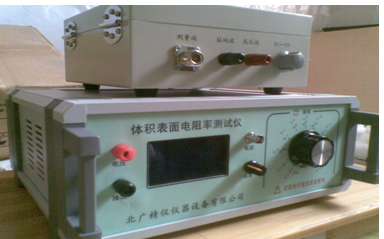
電容器紙絕緣電阻測試儀 保護:測量儀器用的絕緣材料一般只具有與被測材料差不多的性能.試樣的測試誤差可以由下列原因產生:
①外來寄生電壓引起的雜散電流通渠道.通常不知道它的大小,并且有漂移的特點;
②測量線路的絕緣材料與試樣電阻標準電阻器或電流測量裝置的并聯.
使用高電阻絕緣奢侈可以改善測量誤差,但這種方法將使儀器昂貴而又笨重,而且對高阻值試樣的測量仍不能得到滿意的結果.較為滿意的改進方法是使用保護技術,即在所有主要的絕緣部位安置保護導體,通過它截信了各種可能引起誤差的雜散電流;將這些導電聯接在一起組成保護系統,并與測量端形成一個三端網絡.當線路連接恰當時,所有外來寄生電壓的雜散電流被子保護系統分流到測量電路以下,這就可大大減少誤差的可能性.
電容器紙絕緣電阻測試儀 在系統的保護端和被保護端之間存在的電解電勢,接觸電勢或熱電運勢較小時,均能補償掉,使它們在測量中不引起顯著誤差.
在電流測量中,由于被保護端和保護端之間的電阻與電流測量裝置并聯可能產生誤差,因此前者至少應為電流測量裝置輸入電阻的10倍,最好為100倍.在電橋法測量中,保護端與測量端帶有大致相同的電位,但電橋中的一個標準電阻與不保護端和保護端之間的電阻并聯,因此,后者至少為標準電阻的10倍,最好20倍.
在開始測試前先斷開電源和試樣的連線進行一次測量,此時設備應在它的靈敏度許可范圍內指示無窮大的電阻.可用一些已知值的標準電阻業檢查設備運行是否良好.
表面電阻率surface resistivity
在絕緣材料的表面層里的直流電場強度與線電流密度之商,即單位面積內的表面電阻。面積的大
小是不重要的。
注:表 面 電 阻 率 的S1單 位 是Q。實 際 上 有 時 也 用 “歐 每 平 方 單 位 ”來 表 示 。
標準:GB/T 1410-2006《 塑料薄膜電阻率測定儀固體絕緣材料體積電阻率和表面電阻率試驗方法》
GB/T 1410-2006本標準規定了固體絕緣材料體積電阻率和表面電阻率的試驗方法。這些試驗方法包括對固體絕緣材料體積電阻和表面電阻的測定程序及體積電阻率和表面電阻率的計算方法
體積電阻和表面電阻的試驗都受到下列因素影響:施加電壓的大小和時間;電極的性質和尺寸;在
試樣處理和測試過程中周圍大氣條件和試樣的溫度、濕度。
技術指標
1、電阻測量范圍:0.01?104Ω~1?1018Ω。
2、電流測量范圍:2?10-4A~1?10-16A
3、顯示方式:觸摸屏、電阻、電阻率、電流、電壓。
4、內置測試電壓:10V、50V、100V、250V、500V、1000V(任意切換)
5、基本準確度:1%
6、使用環境:溫度:0℃~40℃,相對濕度<80%
7、供電形式:AC220V,50HZ,功耗約5W
8、儀器尺寸:360*350*170mm
9、質量:主機約5KG
影響電阻率的外界因素
電阻率不僅與材料種類有關,而且還與溫度、壓力和磁場等外界因素有關。金屬材料在溫度不高時,ρ與溫度t(℃)的關系是ρt=ρ0(1 at),式中ρt與ρ0分別是t℃和0℃時的電阻率;α是電阻率的溫度系數,與材料有關。錳銅的α約為1?10-1/℃(其數值極小),用其制成的電阻器的電阻值在常溫范圍下隨溫度變化極小,適合于作標準電阻。已知材料的ρ值隨溫度而變化的規律后,可制成電阻式溫度計來測量溫度。半導體材料的α一般是負值且有較大的量值。制成的電阻式溫度計具有較高的靈敏度。有些金屬(如Nb和Pb)或它們的化合物,當溫度降到幾K或十幾K(絕對溫度)時,ρ突然減少到接近零,出現超導現象,超導材料有廣泛的應用前景。利用材料的ρ隨磁場或所受應力而改變的性質,可制成磁敏電阻或電阻應變片,分別被用來測量磁場或物體所受到的機械應力,在工程上獲得廣泛應用。
電阻的作用:
電阻在電路中的作用:利用著名的歐姆定律可以利用電阻控制電路中的電壓、電流。
電阻的主要物理特征就是可以變電能為熱能,因此熱水器中的發熱元件、電燈泡、電燙斗就是利用了電阻的作用制成的。另外電阻有怕熱的特性,當導體材料溫度升高時材料的電阻率會增大(有些材料則表現為減小),因此利用電阻的這種特性可以制作溫度測量計(不知道你看見過沒,插一根“鐵絲”就能測量溫度的方法就是利用了這種電阻材料作用的)。
另外一些材料的電阻還會受到光線照射的印象,而利用這樣的材料可以制成光敏電阻,利用這點作用可以方便的設計光控電路以及光的測量和光電轉換等領域。
安全注意事項
1.使用前務必詳閱此說明書,并遵照指示步驟,依次操作。
2.請勿使用非原廠提供之附件,以免發生危險。
3.進行測試時,本儀器測量端高壓輸出端上有直流高壓輸出,嚴禁人體接觸 ,以
免觸電。
4.為避免測試棒本身絕緣泄漏造成誤差,接儀器測量端輸入的測試棒應盡可 能懸
空,不與外界物體相碰。
5. 當被測物絕緣電阻值高,且測量出現指針不穩現象時,可將儀器測量線屏蔽端夾子接上。例如:對電纜測纜芯與纜殼的絕緣時,除將被測物兩端分別接于輸入端與高壓端,再將電纜殼,芯之間的內層絕緣物接儀器“G”,以消 除因 表面漏 電而 引起的測 量誤 差。也 可用 加屏蔽 盒的 方法, 即將 被測物 置于 金屬屏 蔽盒 內,接 上測 量線。
Safety precautions
1. Be sure to read this manual carefully before use, and operate in sequence according to the instructions.
2. Do not use accessories not provided by the original manufacturer to avoid danger.
3. During the test, there is a DC high-voltage output on the high-voltage output end of the measuring end of the instrument. It is strictly forbidden to touch the human body
No electric shock.
4. In order to avoid errors caused by insulation leakage of the test bar itself, the test bar connected to the measuring end of the instrument shall be suspended as much as possible
It is empty and does not collide with external objects.
6. When the insulation resistance of the measured object is high and the pointer is unstable during measurement, connect the clamp at the shielding end of the measuring line of the instrument. For example, when measuring the insulation between the cable core and the cable shell, in addition to connecting the two ends of the measured object to the input end and the high-voltage end, connect the inner insulation between the cable shell and the core to the instrument "G" to eliminate the measurement error caused by surface leakage. The method of adding a shielding box can also be used, that is, placing the tested object in a metal shielding box and connecting the measuring line.
測試步驟:
1、測試溫度23?2℃,相對濕度65?5%,無外界電磁場干擾環境中進行。
2、測試時對試樣所加電壓為100V~500V的直流電壓,選擇電壓檔次。
3、將試樣倒入高壓電極內,使液面剛好和環電極下緣全部接觸為止。
4、將充分放電后的試樣和電極,按固體(液體)體積及表面電阻率測試儀要求接線。
外電極(高壓電極)接高固體(液體)體積及表面電阻率測試儀的高壓輸出端。
內電極(測量電極)接固體(液體)體積及表面電阻率測試儀的測量端。
中電極(環電極)接固體(液體)體積及表面電阻率測試儀的接地端。
5、儀器預熱30分鐘,穩定后調整儀器(調零),加上試驗1分鐘,讀取電阻指示值,然后放電1分鐘,再測試一次,以二次的算術平均值作為試驗樣品電阻指示值。
表面電阻率 沿試樣表面電流方向的直流電場強度與單位長度的表面傳導電流之比,稱材料的表面電阻率,以符號ρm表示。板狀試樣的表面電阻率可按下式計算:
ρm=Rm[2π?ln(d2?d1)]
式中Rm—試樣表面電阻,即施加在試樣上的直流 電壓與電極間表面傳導電流之比(Ω);
d1—平板測量電極直徑(m);
d2—平板保護電極內徑(m),

Importance and use:
1 The insulating material is used to isolate the electronic systems from each other and from the ground. It can provide mechanical support for parts. For this purpose, the highest possible insulation resistance is usually required to be consistent with acceptable mechanical, chemical and heat resistance. Because the insulation resistance or conductance combines the volume and surface resistance or conductance, the test sample and electrode are required to have the same form in actual use, and the measured value at this time is very useful. The surface resistance or conductance changes rapidly with humidity, while the volume resistance or conductance changes slightly, although the overall change may be greater in some cases.
2 Resistance or conductance can be used to indirectly predict the low frequency dielectric breakdown and loss factor performance of some materials. Resistance or conductance is usually used as an indirect measure of humidity content, curing degree, mechanical continuity or different types of aging. The utility of these indirect measures depends on the degree of correlation established through theoretical or empirical research. The reduction of surface resistance can lead to the increase of dielectric breakdown voltage due to the reduction of electric field strength, or the decrease of dielectric breakdown voltage due to the increase of stress area.
3 All dielectric resistances or conductivities depend on the length of the electrochemical time and the applied voltage (except for ordinary environmental variables). These factors must be known and reported at the same time to make resistance or conductance measurements meaningful. In the electrical insulating material industry, the adjective "apparent" is usually applicable to the resistance value obtained under the condition of arbitrarily choosing the electrochemical time. See X1.4.
4 The volume resistance or conductance can be calculated from the resistance and size data used to design an insulator for a specific application. Studies have shown that resistance or conductance varies with temperature and humidity (1,2,3,4) 4, and this change must be known when designing operating conditions. The volume resistance or conductance measurement value is usually used to check the uniformity of insulating materials, or for processing, it can detect conductive impurities that affect the quality of materials, which is not easily observed by other methods.
5 When the volume resistance exceeds 1021Ω?cm (1019Ω?cm), the volume resistance is calculated from the value obtained from the test of the sample under ordinary laboratory conditions. If the result is really suspicious, the limitations of the commonly used measuring equipment should be considered.
6 The surface resistance or conductance cannot be measured accurately, but can only be measured approximately, because the volume resistance or conductance is always affected by the measurement method. The measured values are also affected by surface contamination. Surface contamination and its accumulation rate are affected by many factors, including electrostatic charging and interfacial tension. These factors in turn can affect surface resistance. When pollution is included, but the material properties that are not electrical insulating materials are judged under common sense, the surface resistance or conductance can be regarded as related to the material properties.
業務咨詢:932174181 媒體合作:2279387437 24小時服務熱線:15136468001 盤古機械網 - 全面、科學的機械行業免費發布信息網站 Copyright 2017 PGJXO.COM 豫ICP備12019803號